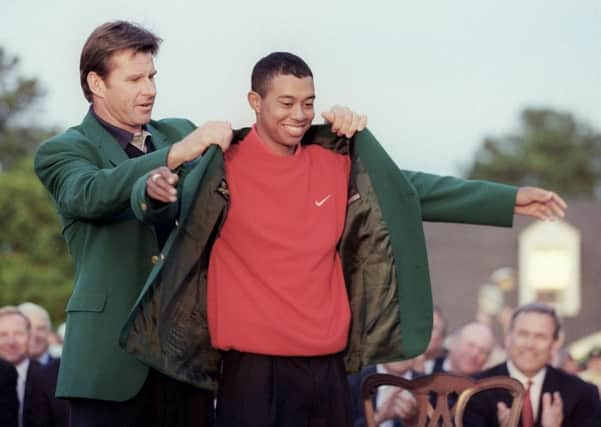How Tiger Woods made golf cool by '˜dismantling' Augusta


The margin of victory is a record. So, too, is his 18-under-par 270 total, though that is now shared with Jordan Spieth after he matched it two years ago. The Sunday audience of 44 million is a record that still stands. That was the day when a 21-year-old, the first non-white player to win at Augusta National, sparked an era of remarkable dominance. He claimed the US Open title by 15 shots three years later at Pebble Beach. It is widely acclaimed as the best-ever performance in golf. The first of four Masters triumphs and 14 major victories overall, though, runs it pretty darned close.
“What Tiger did in 1997 was so unusual in the fact that he was able to overpower the golf course in a way that we hadn’t seen by anybody, other than Jack Nicklaus,” noted two-time US Open champion and ESPN commentator Andy North. “He got off to a poor start (Woods was out in four-over in the first round) but, once he got it going, it never stopped that year. He was a ridiculous amount of strokes under par for the par-5s that week. He hit driver, wedge; driver, 9-iron; driver, 8-iron literally to every single one of them. He just completely overpowered it. And this was a signal that the rest of the golf world was going to be in a lot of trouble if they expected to beat this guy.
Advertisement
Hide AdAdvertisement
Hide Ad“I think that in itself is the one thing that stuck out to me, the way he made the golf course look so simple and indefensible.”
After managing to salvage a 70 in that opening round, he sat three shots off the lead, held by John Huston. A second-round 66 then lifted Woods into top spot on eight-under, three shots ahead of Colin Montgomerie in second place. The Scot had no answer as Woods kept his foot on the pedal with a 65 in the third circuit. That moved him nine shots clear of the field. The last round was a procession. Woods closed with a 69 to better the previous record, held by both Nicklaus in 1965 and Raymond Floyd, by one shot. It was the signal for Tiger-mania to hit golf.
“Over the last 20 years, he changed so many things in the game and then outside the game in much the same way that we saw Arnold [Palmer] do it back in the late ’50s and early ’60s, with television. The television contracts exploded,” added North. “Off the golf course, income for these guys exploded because of Tiger. He made golf cool for a lot of younger kids.
“Did he bring hundreds of millions of people into the game? No. That wasn’t going to happen. But he made golf cool. If you were a kid playing in a high-school golf team back in the late ’90s and early 2000s, all of a sudden now you were proud to walk through the front door of the school with your golf clubs to put in your locker, versus trying to sneak them in the back door. All of a sudden people recognised that golf was a sport that meant something.”
Another two-time US Open champion, Curtis Strange, concurs. “I think what Tiger did for the game and the big picture of the game and outside the game was fabulous,” said Strange, who will also be a member of the ESPN team covering the Masters this week. “It wasn’t so much him hitting the golf ball and making putts, it was what he did outside of the game. He brought people to the game, doubled TV ratings, increased the purses, just by being the dominant player.”
That, of course, is no longer the case. Not for some time now, in fact, and Woods will only be at Augusta National this week to attend the traditional Champions Dinner on Tuesday. He is not “tournament ready”, having been out of action since he withdrew following the opening round of the Dubai Desert Classic at the beginning of February due to back trouble. It is doubtful we will ever see him in full flight again, to be honest, but memories of 1997 will never really fade. It was the start, after all, of a memorable era for golf.
“I think that there was a point in time that you just figured that he was going to win there pretty much every year. Or if he didn’t win, it was an upset,” said North. “The golf course is perfectly built for him. Even when they went through the process of “Tiger proofing” the golf course, that just made it better for him because it eliminated all the guys that couldn’t hit it like he did. Mike Tirico (ESPN’s golf anchor) and I used to have a little bet for dinner that I took Tiger and he had the rest of the field and I won seven out of 11 majors at one stretch with it. I mean that’s ridiculous. We have never seen that in this sport before and we probably will never see it again.
“Obviously, the last five or six years has not gone that way, but yet even in some of the periods where he would come into the Masters maybe not at his best or coming off an injury, he still had a chance to win a bunch of them. You can go back over the last ten years and probably could find five or six of them that he could have won as easily as he didn’t. His game was the perfect match for the golf course and anything he did there, even in the future, wouldn’t surprise me.